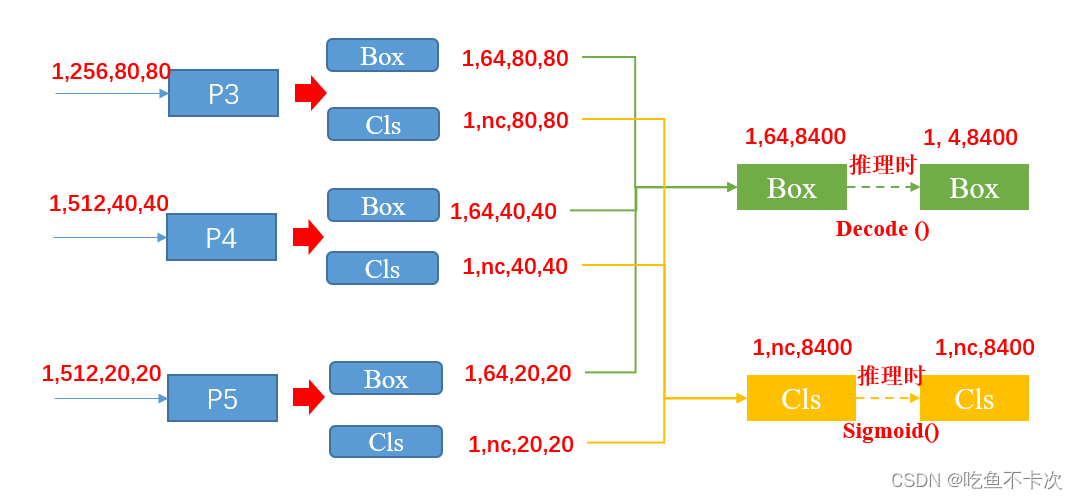YOLOv5网络结构性能优化:提升检测精度,降低计算成本,实现高效部署
发布时间: 2024-07-20 03:02:03 阅读量: 29 订阅数: 41 


# 1. YOLOv5网络结构概述
YOLOv5是目标检测领域中广受认可的算法,其网络结构融合了多种先进技术,在精度和速度方面取得了出色的平衡。本章将概述YOLOv5的网络结构,包括其主要组件和它们之间的交互方式。
### 1.1 Backbone:CSPDarknet53
YOLOv5的Backbone采用CSPDarknet53,这是一个基于Darknet53的改进版本。CSPDarknet53引入了一种称为Cross-Stage Partial Network (CSP)的结构,它将卷积层划分为多个阶段,并通过残差连接将它们连接起来。这种设计可以减少计算成本,同时保持较高的特征提取能力。
### 1.2 Neck:SPP + PAN
Neck模块负责将Backbone提取的特征图融合成用于目标检测的最终特征图。YOLOv5采用Spatial Pyramid Pooling (SPP)和Path Aggregation Network (PAN)的组合。SPP将特征图划分为不同大小的区域,并从每个区域提取特征。PAN将这些特征图连接起来,形成一个具有丰富语义信息的最终特征图。
# 2. YOLOv5网络结构优化
### 2.1 Backbone优化
YOLOv5的Backbone网络采用CSPDarknet53作为主干网络,CSPDarknet53在Darknet53的基础上进行了改进,引入了CSP(Cross Stage Partial)结构,提高了网络的特征提取能力和计算效率。
#### 2.1.1 CSPDarknet53优化
CSPDarknet53将Darknet53中的残差块替换为CSP结构,CSP结构将残差块分为两部分,一部分直接连接到下一层,另一部分经过卷积和残差连接后再连接到下一层。这种结构可以减少计算量,同时保持网络的特征提取能力。
```python
import torch
from torch import nn
class CSPDarknet53(nn.Module):
def __init__(self):
super(CSPDarknet53, self).__init__()
# ...
self.csp1 = nn.Sequential(
nn.Conv2d(512, 256, 1, bias=False),
nn.BatchNorm2d(256),
nn.ReLU(),
nn.Conv2d(256, 512, 3, padding=1, bias=False),
nn.BatchNorm2d(512),
nn.ReLU(),
)
self.csp2 = nn.Sequential(
nn.Conv2d(512, 256, 1, bias=False),
nn.BatchNorm2d(256),
nn.ReLU(),
nn.Conv2d(256, 512, 3, padding=1, bias=False),
nn.BatchNorm2d(512),
nn.ReLU(),
)
# ...
def forward(self, x):
# ...
x = self.csp1(x)
x = self.csp2(x)
# ...
return x
```
#### 2.1.2 Focus优化
Focus层是YOLOv5网络中用于处理输入图像的第一个层,它将输入图像缩小到1/4的尺寸,同时增加通道数。这种操作可以减少后续网络层的计算量,同时保持网络的特征提取能力。
```python
import torch
from torch import nn
class Focus(nn.Module):
def __init__(self, in_channels, out_channels):
super(Focus, self).__init__()
self.conv = nn.Conv2d(in_channels, out_channels, 3, padding=1, bias=False)
def forward(self, x):
return self.conv(x)
```
### 2.2 Neck优化
YOLOv5的Neck网络采用SPP(Spatial Pyramid Pooling)和PAN(Path Aggregation Network)结构,SPP结构可以提取不同尺度的特征,PAN结构可以融合不同尺度的特征,提高网络的特征融合能力。
#### 2.2.1 SPP优化
SPP结构将输入特征图划分为多个不同大小的区域,然后对每个区域进行最大池化操作,提取不同尺度的特征。这些特征可以提供更丰富的上下文信息,提高网络的检测精度。
```python
import torch
from torch import nn
class SPP(nn.Module):
def __init__(self, in_channels, out_channels):
super(SPP, self).__init__()
self.pool1 = nn.MaxPool2d(5, stride=1, padding=2)
self.pool2 = nn.MaxPool2d(9, stride=1, padding=4)
self.pool3 = nn.MaxPool2d(13, stride=1, padding=6)
self.conv = nn.Conv2d(in_channels * 3, out_channels, 1, bias=False)
def forward(self, x):
x1 = self.pool1(x)
x2 = self.pool2(x)
x3 = self.pool3(x)
x = torch.cat([x1, x2, x3], dim=1)
return self.conv(x)
```
#### 2.2.2 PAN优化
PAN结构将不同尺度的特征图进行融合,融合后的特征图包含了丰富的上下文信息和不同尺度的特征,提高了网络的检测精度和目标定位能力。
```python
import torch
from torch import nn
class PAN(nn.Module):
def __init__(self, in_channels):
super(PAN, self).__init__()
self.conv1 = nn.Conv2d(in_channels, in_channels, 3, padding=1, bias=False)
self.conv2 = nn.Conv2d(in_channels * 2, in_channels, 3, padding=1, bias=False)
self.conv3 = nn.Conv2d(in_channels * 3, in_channels, 3, padding=1, bias=False)
def forward(self, x1, x2, x3):
x1 = self.conv1(x1)
x2 = self.conv2(torch.cat([x1, x2], dim=1))
x3 = self.conv3(torch.cat([x1, x2, x3], dim=1))
return x3
```
### 2.3 Head优化
YOLOv5的Head网络采用YOLO Head和Anchor优化,YOLO Head负责预测目标的类别和位置,Anchor优化可以提高网络的定位精度。
#### 2.3.1 YOLO Head优化
YOLO Head采用一个1x1的卷积层,将输入特征图转换为一个包含目标类别和位置预测的张量。
```python
import torch
from torch import nn
class YOLOHead(nn.Module):
def __init__(self, in_channels, num_class
```
0
0





